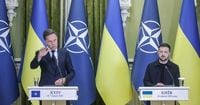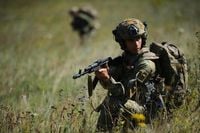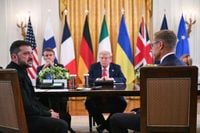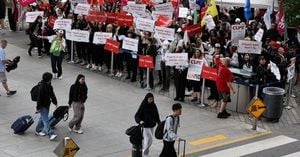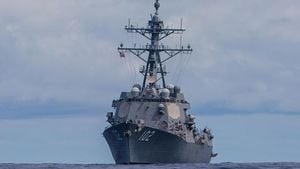In a week marked by diplomatic flurries, military posturing, and high-stakes negotiations, efforts to secure Ukraine’s future have taken center stage on the world stage. With the war between Russia and Ukraine grinding into its fourth year, the United States, European allies, and Ukraine’s own leadership are pushing hard for a breakthrough—yet the path remains fraught with obstacles, sharp rhetoric, and the ever-present threat of escalation.
On Monday, August 18, 2025, President Donald Trump hosted a historic meeting at the White House with Ukrainian President Volodymyr Zelenskyy and seven European leaders. The critical outcome was an agreement to form a joint commission tasked with developing security guarantees for Ukraine, a move reported by The Hill and NewsNation. Secretary of State Marco Rubio, who also serves as Trump’s national security adviser, was named head of this new commission, which will bring together officials from the U.S., Ukraine, Europe, and NATO. The commission’s mission is clear: craft a credible, enforceable security framework to deter future Russian aggression once the guns fall silent.
According to The Wall Street Journal, the envisioned security assurances for Ukraine would rest on four pillars: robust air defense, a continued military presence, monitoring of any ceasefire, and the provision of advanced weaponry. Yet, as the week unfolded, the optimism that initially surrounded these talks began to falter.
Just days before the White House summit, Rubio participated in a closed-door session with Russian President Vladimir Putin—an encounter that underscored the complexity of bringing Moscow to the negotiating table. On Monday, after his meetings with Zelenskyy and European leaders, Trump spoke with Putin by phone for about 40 minutes. Notably, neither Zelenskyy nor the European officials were present for this call. As Trump later explained to Fox News, "I didn’t do it in front of them — I thought that would be disrespectful to President Putin. I wouldn’t do that, because they have not had the warmest relations."
Trump has made no secret of his desire to end the conflict, which has raged for more than three and a half years. He’s floated the idea of providing U.S. air support for Ukraine as part of any security guarantees, telling reporters, "We’re willing to help them with things, especially, probably — if you talk about by air, because nobody has stuff we have." However, he’s ruled out sending American troops directly into Ukraine, a red line that remains firm even as European leaders press for a more muscular U.S. military presence in the region.
Indeed, European countries are pushing Trump to send American F-35 fighter jets to Romania, where NATO is building its largest European airbase, as a visible deterrent to further Russian aggression. As The Times and Reuters report, military chiefs from both sides of the Atlantic gathered in Washington on August 20 to hash out the details. Britain’s Chief of Defence Staff, Admiral Sir Tony Radakin, met with his NATO and U.S. counterparts, while NATO’s military committee held what was described as a "great, candid discussion" about the way forward. The focus: how to structure security guarantees that are credible, durable, and, crucially, acceptable to all parties involved.
But Moscow has been quick to push back. Russian Foreign Minister Sergey Lavrov has repeatedly insisted that Russia must be included in any talks about Ukraine’s security. "Seriously discussing security issues without Russia is a road to nowhere," Lavrov said, as quoted by Ria Novosti and BBC. He’s called for security guarantees to be based on a draft accord from 2022, which would have included all five permanent members of the UN Security Council—China, Russia, the U.S., Britain, and France. Ukraine rejected that proposal at the time, wary of giving Moscow a de facto veto over its security arrangements. Lavrov also floated the idea of including China as a guarantor, but Ukrainian President Zelenskyy swiftly ruled out Beijing’s involvement.
Meanwhile, the prospects for direct talks between Putin and Zelenskyy have dimmed. On Friday, August 22, Lavrov told NBC’s "Meet the Press" that "there is no meeting planned" and that Putin would only meet Zelenskyy after senior officials had hammered out an acceptable agenda—a process that could drag on indefinitely. The Kremlin’s lack of enthusiasm was punctuated by Putin’s visit to Sarov, a city synonymous with Russia’s nuclear weapons program, a not-so-subtle reminder of Russia’s military might.
On the ground, the war shows no signs of abating. Thursday, August 21, saw one of Russia’s largest aerial assaults of the year, with 574 drones and 40 ballistic and cruise missiles raining down on western Ukraine. Ukrainian forces, meanwhile, continue to train and fight, as images from Kharkiv show young soldiers honing their skills on the frontlines. The toll on civilians remains staggering, with deadly strikes reported in cities like Kostiantynivka, where local officials accuse Russian forces of deliberately targeting non-combatants.
As the diplomatic dance continues, European officials are increasingly wary of what they see as Russian attempts to set traps at the negotiating table. European Union foreign policy chief Kaja Kallas warned that any deal requiring Ukraine to cede territory would be "exactly the trap that Russia wants us to walk into." Speaking to the BBC, she added, "Russia is just dragging feet. It’s clear that Russia does not want peace. President Trump has been repeatedly saying that the killing has to stop and Putin is just laughing, not stopping the killing, but increasing the killing."
Despite these setbacks, Ukraine and its allies are pressing ahead with plans for a postwar security architecture. Zelenskyy’s chief of staff, Andrii Yermak, confirmed that work is underway on a military component of the guarantees, and Lithuania has pledged to contribute troops and equipment to any future peacekeeping mission. The U.S., for its part, is reportedly considering Budapest as a venue for a possible Zelenskyy-Putin summit, though no date has been set and the location could change.
Trump, for now, is keeping his options open. On Friday, he told reporters he would decide within two weeks whether to impose new sanctions or tariffs on Russia if direct talks fail to materialize. "We’re going to see whether or not they have a meeting," he said. "It’ll be interesting to see. If they don’t, why didn’t they have a meeting, because I told them to have a meeting. But I’ll know what I am going to do in two weeks."
As the world watches, the stakes couldn’t be higher. With diplomatic momentum stalling, military tensions rising, and the human cost mounting, the quest for lasting security and peace in Ukraine remains as urgent—and as elusive—as ever.
